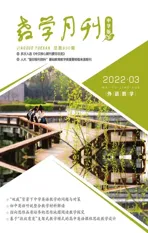英语阅读教学中指向批判性思维培养的可视化思维策略运用
2022-03-28蔡瑞琼浙江省杭州绿城育华学校
蔡瑞琼|浙江省杭州绿城育华学校
思维品质指思维在逻辑性、批判性、创新性等方面所表现的能力和水平[1],体现英语学科核心素养的心智特征。其中,批判性思维包括批判性思维技能和批判性思维倾向,是学生思维由低阶向高阶发展的原动力。批判性思维技能包括解读(interpretation)、分析(analysis)、评价(evaluation)、推理(inference)、解释(explanation)和自我调节(self-regulation)六项认知技能[2]。批判性思维倾向则包括寻找真理、开放思想、分析能力、系统化能力、自信心、探究能力、认知成熟度[3]。批判性阅读是培养批判性思维的重要途径[4]。然而,目前的初中英语阅读教学往往集中在语言知识和语言技能层面,忽视了学生批判性思维的培养[5]。
可视化思维策略是指运用具体的思维工具来体现学生思维方式的一种可视化策略,可以帮助学生实现更深层次的理解,提升学生的思维品质[6]。哈佛大学Project Zero(零点计划)提出的“Circle of Viewpoints”“Claim-Support-Question”“Compass Points”“Connect-Extend-Challenge”“I Used to Think...Now I Think”“See-Think-Wonder”“Think-Pair-Share”“Think-Puzzle-Explore”“What Makes You Say That?”等可视化思维策略的核心理念在于思维模式是可教授的,这为思维教学提供了有效的工具。本文基于校本拓展教材《剑桥新思维英语青少版学生用书》(外语教学与研究出版社),探讨“See-Think-Wonder”“Connect-Extend-Challenge”和“Circle of Viewpoints”三种可视化思维策略分别运用于英语阅读教学的读前导入、读中理解以及读后讨论三个环节中对培养学生批判性思维能力的作用。
一、在读前导入环节,借助“See-Think-Wonder”培养学生的推理和解读技能
在读前导入环节,可视化思维策略“See-Think-Wonder”可以帮助学生对文章内容进行预测,培养学生的推理和解读技能[7]。“See”引导学生仔细观察图片并进行描述;“Think”引导学生在图片与已有认知间建立联系,进而推断出图片的寓意;“Wonder”鼓励学生在“See”和“Think”的基础上对文本内容进行推理,激发学生的阅读兴趣。下面以第八单元“Spend the vacation of a lifetime—in a cave!”为例进行阐述。
首先,教师以“See”为起点,引导学生观察并描述图片。“Spend the vacation of a lifetime—in a cave!”讲述的是西班牙旅游城市瓜迪克斯的洞穴酒店,且附有一幅组合插图(如图1所示)。在读前导入环节,教师借助图1,提出问题“What do you see from the picture?”,引导学生对图片进行描述。

图1 组合插图
【教学片段1】
T:What do you see from the picture?
S1:I see mountains,trees,plants,windows,doors and a ladder.
T:Anything else?
S2:(I see)houses.
T:Where are the houses?
S2:In the mountains.
T:So they are more like caves which have the functions of houses.
在“See”这一起点环节,教师应引导学生观察图片,并尽可能全面地描述观察到的内容,但无需解释图片信息间的内在联系。由教学片段1可知:S1从直观上罗列出图1的事物;S2则从整体视角对图1进行了描述,并提出“houses”。此时,教师通过问题“Where are the houses?”,引出文章主题“cave”。如果学生观察不全面,教师则可通过“Anything else?”进行追问。
其次,教师以“Think”为支点,引导学生辨析内在联系。在铺垫必要的图片信息之后,教师提出问题“Who/What...do you think...?”,即以“Think”为支点,引导学生在图片与已有认知间建立联系。
【教学片段2】
T:What facilities do you think does the cave have?And why?
S1:I think it has water and electricity,which are necessary to our daily life.
S2:I think there is also Wi-Fi connection in the cave.If not,probably no one likes to live there.
S3:I don’t think there will be Wi-Fi connection in the deep mountain.It’s good to stay close to nature instead of phones.
T:Both S2 and S3 mentioned“Wi-Fi connection”,we can also call it broadband connection.It doesn’t matter that you have different understandings about whether there is broadband connection in the cave.
在教学片段2中,学生基于已有认知对洞穴的设施展开讨论。在此基础上,教师提出问题“Who do you think will live in the cave?And why?”,引导学生展开进一步的思考。这不仅有助于培养学生的推理、分析等批判性思维技能,而且也可以为后续的文本阅读作铺垫。在这一过程中,教师引导学生进行“Think-Pair-Share”,即独立思考、与同伴交流以及成果分享。部分学生的成果分享如下:
S1:It can be so expensive to live in this special cave,and I think only rich people can afford it.
S2:I think only poor people who can’t afford houses in the city or suburb will live in this special cave.
再次,教师以“Wonder”为切点,引导学生对文章内容进行推测。在“See”和“Think”环节,学生已经对“cave”有了一定的了解。因此,教师在“Wonder”环节创设Post-it活动,引导学生运用句式“I want to know...”来对文章内容进行推测。学生基于各自的兴趣点积极发言,部分发言如下:
S1:I want to know where to find these caves.
S2:I want to know what the caves are used for.
S3:I want to know what facilities the caves really have.
S4:I want to know when the caves were built.Do they have a long history?
借助可视化思维策略“See-Think-Wonder”,教师可以引导学生观察文本插图,培养学生解读图片以及推测文章内容的能力,激发学生的阅读期待。
二、在读中理解环节,借助“Connect-Extend-Challenge”培养学生的解读和评价技能
在读中理解环节,可视化思维策略“Connect-Extend-Challenge”可以帮助学生将已有认知与文本信息联系起来,进而在充分解读文本信息的基础上对其进行评价。“Connect”引导学生在解读文本信息的基础上,运用已有知识进行思维加工;“Extend”旨在拓宽学生思维的广度和深度;“Challenge”引导学生对文本信息进行评价。下面以第九单元“Your brain is like a muscle—use it or lose it!”为例进行阐述。该语篇讲述的是如何提升记忆力。语篇的前半部分讲述提高记忆力的方法,后半部分则阐述如何利用编写故事来提升记忆力。该语篇结构清晰,生词较少,适合学生进行自主阅读。
首先,教师引导学生以三人为一组,借助“Connect-Extend-Challenge”任务单(如表1所示)进行自主阅读,以促使学生将已有知识与语篇信息联系起来。

表1 “Connect-Extend-Challenge”任务单
然后,教师提供语言支架“I used to know/think that…(Connect),but after reading the passage I know that…(Extend).However,I want to challenge the idea because…(Challenge)”,引导学生对文本内容进行解读和评价。下面是两位学生的思维路径:
S1:I used to think that it was a waste of time to remember a list of vocabulary by making a picture story(Connect),but after reading the passage I know that our brain works a lot in picture stories(Extend).However,I want to challenge the idea because my classmates and I usually find it more difficult to make a picture story than to remember vocabulary(Challenge).
S2:I used to think it was good to remember as many words as possible at one go(Connect),but after reading the passage I know that it’s not good to over-train our brain,so we should stop when we’ve remembered a list of vocabulary(Extend).However,I want to challenge the idea because human brains can be so different that it’s hard to define“over-train”(Challenge).
两位学生分别基于自身经历,辩证分析语篇所阐述的记忆方法的有效性。
接着,教师引导其余学生对上述两位学生的辨析进行评价,部分学生的观点阐述如下:
S3:Although it may take more time to make a picture story before remembering the vocabulary,you can find that your memory can last much longer by making picture stories.(评价S1)
S4:I think what the passage really means is that if you find that you are tired when you remember a list of vocabulary,then just stop.Take a break for about 20 minutes,and your brain will work well again.You don’t have to challenge the reasoning because of the word“over-train”.(评价S2)
借助可视化思维策略“Connect-Extend-Challenge”,教师可以引导学生将已有知识与文本信息联系起来,并对文本信息展开思考和评价。这有助于培养学生的解读和评价技能。
三、在读后讨论环节,借助“Circle of Viewpoints”培养学生的开放思想和认知成熟度
批判性思维倾向包括灵活而开放、愿意自我纠正的策略,意识到在现实面前要作出妥协的准备[8]。可视化思维策略“Circle of Viewpoints”运用头脑风暴的方式展开讨论,有助于培养学生的开放思想和认知成熟度。下面以第三单元“Bicycle Revolution?”为例进行阐述。
“Bicycle Revolution?”讲述的是巴黎市政府为了改善交通和环境问题,推出共享单车项目的事件。在读后讨论环节,教师提出问题“To what extend can the bicycle program benefit the city?”,引导学生对共享单车项目进行头脑风暴。部分学生的观点展示如下:
S1:The bicycle program is very helpful especially when there are lots of traffic jams.We can take a bicycle,use it for as long as we want.(益处)
S2:You know,travelling by bicycle can reduce air pollution in the atmosphere.(益处)
S3:I notice that people sometimes park bicycles in a disorganized way,and some shared bikes are even thrown into rivers.It looks annoying.(弊端)
S4:Even though there’s a notice on each shared bike that kids below 12 are not allowed to ride bikes.What if they ride them on the side street?It can be very risky.(弊端)
学生从交通、环境、市貌、安全等角度对共享单车项目进行头脑风暴。可视化思维策略“Circle of Viewpoints”的核心在于引导学生从多角度看待问题。由于不同学生的成长背景、生活环境、个人经历不同,他们对同一事物的认知会有所不同。基于此,针对上述两个问题,教师提供语言支架“I’m thinking of the bicycle program from the point of view of...(不同的角色立场).I think...(观点)because...(阐述理由)”,引导学生四人一组(分别扮演市长、市民、共享单车运营商、某自行车生产商)展开讨论,形成一致的观点并阐述理由。部分小组的观点如下:
S1:I’m thinking of the bicycle program from the point of view of the mayor of Hangzhou.I think the bicycle program brings more advantages than disadvantages to our city because biking is great for the environment.It cuts down the emission of exhaust fumes,and the global warming problem will not be more and more serious.Also,the traffic problem can be relieved,because some people may ride bikes for short journeys.
S2:I’m thinking of the bicycle program from the point of view of the Hangzhou citizen.I think the bicycle program brings both advantages and disadvantages.On one hand,the shared bicycles are convenient for us.You can take a bicycle,use it for as long as you want,and then leave it at any bicycle station.On the other hand,some shared bicycles are placed randomly on sidewalks,and it sometimes causes inconvenience to the pedestrians.
可视化思维策略“Circle of Viewpoints”的使用可以使学生养成以开放的思想分析问题、形成观点和策略以及进行自我纠正的能力,提高学生的认知成熟度。此外,教师应鼓励学生在讨论和汇报时运用文本中的目标词汇,如traffic jams、as long as、exhaust fumes、short journey、atmosphere等,以使学生迁移运用所学知识。
总 之,“See-Think-Wonder”“Connect-Extend-Challenge”和“Circle of Viewpoints”等可视化思维策略不仅可以呈现学生思考的过程与路径,而且也有助于培养学生的推理、解读、评价等批判性思维技能,以及开放思想、认知成熟度等批判性思维倾向。初中英语阅读教学是培养学生批判性思维能力的重要渠道,教师应探究不同可视化思维策略对培养学生批判性思维技能与批判性思维倾向的意义。在英语阅读教学中,教师应将阅读教学的重点从单纯的语言知识传授转移到思维品质的培养上来,以实现培养学生学科核心素养的目的。□◢
